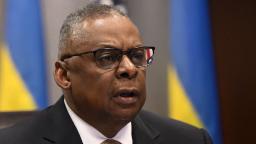CNN
—
Defense Secretary Lloyd Austin vowed on Wednesday that US aircraft will continue to “fly and to operate wherever international law allows,” one day after Russian aircraft hit a US drone over the Black Sea, forcing it to be brought down in international waters.
“This hazardous episode is part of a pattern of aggressive, and risky, and unsafe actions in international airspace,” Austin said at the beginning of a meeting of the Ukraine Defense Contact Group. “So make no mistake, the United States will continue to fly and to operate wherever international law allows. And it is incumbent upon Russia to operate as military aircraft in a safe and professional manner.”
Austin was the first Cabinet member in the Biden administration to directly address the incident, which happened on Tuesday when two Russian Su-27 aircraft intercepted a US MQ-9 Reaper drone. President Joe Biden was briefed on the incident by national security adviser Jake Sullivan on Tuesday.
Austin confirmed on Wednesday at a Pentagon news briefing that he had spoken to his Russian counterpart, Defense Minister Sergei Shoigu, adding that it was critical “great powers be models of transparency and communication.”
The downing of the drone marked the first time Russian and US military aircraft have come into direct physical contact since Moscow launched its invasion of Ukraine a year ago. On Wednesday, a Kremlin spokesperson said that relations between Moscow and Washington are at their “lowest point.” However, the US has not yet announced it is taking any action against Russia over the incident, suggesting the Biden administration may be looking to avoid escalating matters further.
Chairman of the Joint Chiefs of Staff Gen. Mark Milley said Wednesday at the news briefing that the US does “not seek armed conflict with Russia, and I believe that at this point, we should investigate this incident and move on from there.”
The Russian aircraft, Pentagon spokesman Brig. Gen. Patrick Ryder said Tuesday, flew in the vicinity of the drone for 30 to 40 minutes before one of the aircraft hit the MQ-9, resulting in the US bringing the drone down into the water.
US Secretary of State Antony Blinken, speaking at a news conference later Wednesday in Addis Ababa, Ethiopia, declined to speculate as to a Russian motive behind the incident but called it a “reckless and unsafe action.”
Two US officials familiar with the intelligence told CNN that senior officials at the Russian Ministry of Defense gave the order for the Russian fighter jets to harass the US drone, suggesting that the pilots were not taking rogue action when they interfered with the US drone.
At this time, however, there is no indication that the highest of political leaders in Russia – particularly those in the Kremlin, including President Vladimir Putin – knew about the planned aggression in advance, one of the US officials said.
State Department spokesperson Ned Price indicated Wednesday night that there was likely high-level approval of the harassment.
“Our aircraft, our drones have been harassed by Russian pilots almost consistently. And to say that that consistent pattern is the consequence of pilots doing this, Russian pilots doing this on their own volition, that just didn’t ring true,” Price told CNN’s Anderson Cooper on “AC360.” “The fact that we’ve seen a pattern on the part of the forces of the Russian Federation suggests to us at least there’s at least some senior level approval of this kind of activity.”
Whether the military officials set out to plan an incident where the fighter jets would come into physical contact with the drone remains unclear.
“We know that the intercept was intentional. We know that the aggressive behavior was intentional, and we also know it was very unprofessional and very unsafe,” Milley said at the briefing. “The actual contact of the fixed-wing Russian fighter with our UAV, the physical contact with those two, not sure yet.”
National Security Council communications coordinator John Kirby told “CNN This Morning” earlier Wednesday that the drone had not been recovered and that he was “not sure” the US would be able to recover it. He previously told CNN’s Jake Tapper that the US took steps “to protect our equities with respect to that particular drone.”
The US erased sensitive software on the drone remotely before it crashed to prevent Russia from collecting secret information, two US officials told CNN.
Russia had reached the MQ-9 crash site in the Black Sea, two officials told CNN Wednesday, as the Kremlin promises to attempt to recover the US surveillance drone.
Kirby would not confirm that Russians had reached the site but told CNN’s Wolf Blitzer on “The Situation Room” that the US had “made it impossible for them to be able to glean anything of intelligence value off the remnants of that drone, whatever remnants there might be on the surface of the water.”
Russia made clear earlier Wednesday it would attempt to retrieve the wreckage of the drone.
“I don’t know if we will be able to get it or not, but we need to do it… And we will definitely look into it,” Russian Security Council Secretary Nikolai Patrushev said on Russian state TV channel Rossiya 1.
Russia’s Navy has several ships in the Black Sea, including ships based in Crimean ports, which would have placed them in an advantageous position to attempt the recovery.
The US does not have any Navy ships in the Black Sea, according to a Navy official, which would make any attempted US recovery effort extremely difficult and time-consuming.
Milley confirmed on Wednesday that the US does not have any ships in the Black Sea but said the US does “have a lot of allies and friends in the area.”
“We’ll work through recovery operations, that’s US property, and we’ll leave it at that at this point,” Milley said. He added that the drone “probably broke up” and there was “probably not a lot to recover.”
“As far as the loss of anything of sensitive intelligence etc, as normal we would take — and we did take — mitigating measures,” he said. “So we are quite confident that whatever was of value is no longer of value.”
The mid-air encounter occurred approximately 45 miles southwest of the Crimean peninsula, one of the US officials said. The MQ-9 landed approximately 70 miles southwest of Crimea after gliding away from the occupied territory, the official added.
Russia has denied the US’ account of the incident, with Russian Ambassador to the US Anatoly Antonov saying Tuesday that Russia had “informed about this space that was identified as a zone for special military operation.” Antonov also said that the MQ-9 “flew with its transponders off, violating the boundaries of the temporary airspace,” and that Russian aircraft did not come into contact with it.
Milley said Wednesday that while he did not know whether the physical contact between the aircraft and drone was intentional, the intercept and “aggressive behavior was intentional.”
The Kremlin continued its defense on Wednesday, with spokesperson Dmitry Peskov telling reporters to focus on the ministry of defense’s statement, “which clearly states that no weapons were used, and there was no physical contact.”
Peskov said relations between the US and Russia are in a “deplorable state” and at their “lowest point,” adding that Russian President Vladimir Putin was briefed on the incident.
Milley said he has a call scheduled soon with the Chief of Russian General Staff, Gen. Valery Gerasimov, by telephone on Wednesday. The two military leaders have not spoken since late-December.
Oleksiy Danilov, Secretary of Ukraine’s National Security and Defence Council, described the incident as a “signal” of Putin’s “readiness to expand the conflict zone with the involvement of other parties.”
“The incident with the American MQ-9 Reaper UAV, provoked by [R]ussia in the Black Sea, is [P]utin’s signal of readiness to expand the conflict zone with the involvement of other parties,” he said. “The all-in tactic is the constant raising of rates in conditions of a strategic loss and hoping that circumstances would change.”
This story has been updated with additional reporting.








More News
After Apartheid
Columbia’s University Senate Is Said to Be Redrafting Resolution Admonishing Its President
Blinken meets Xi, and Supreme Court Considers Presidential Immunity